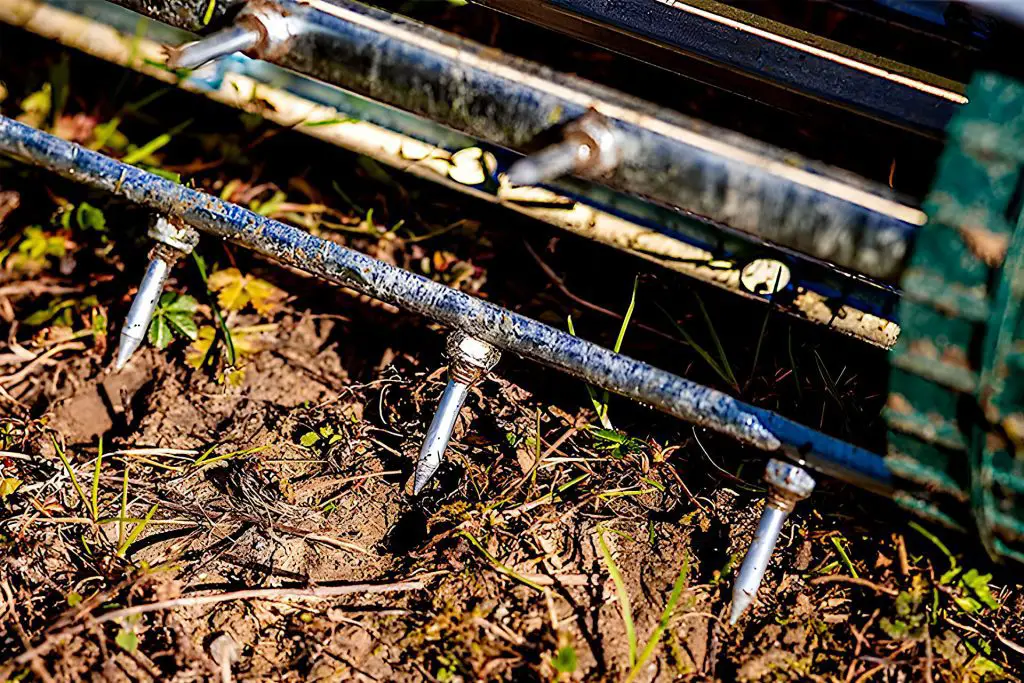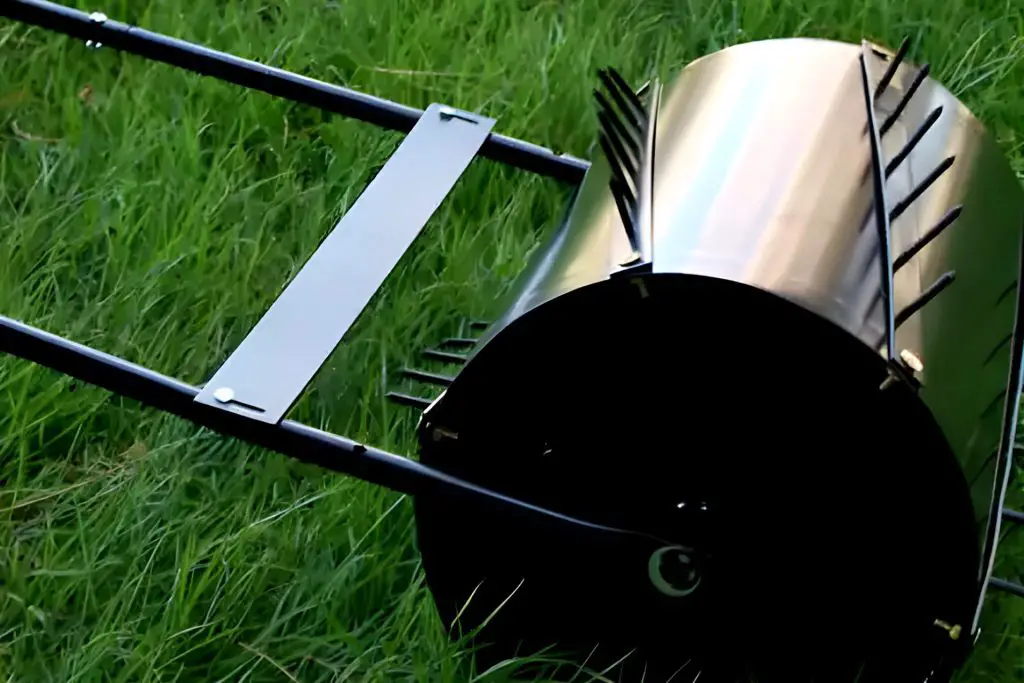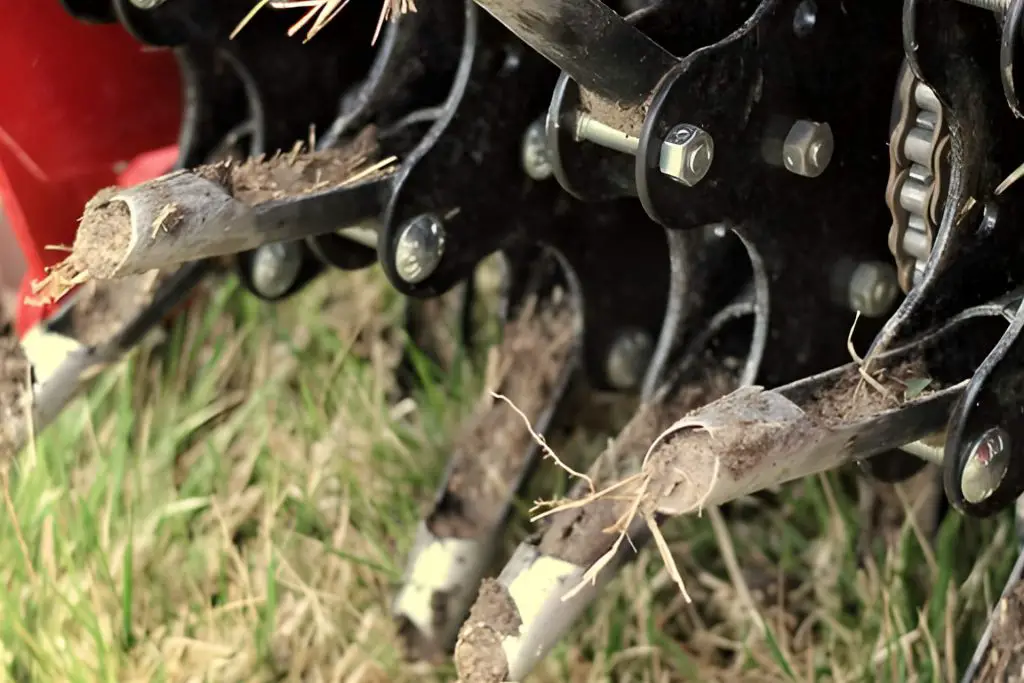Spike vs Plug Aerator: What Are the Differences and Which Is Best for You?
There are many benefits to aerating your lawn and it is indeed often essential if you want to maintain a fantastic healthy looking beautiful lawn year after year. Aeration should in fact form part of the core maintenance you should conduct every year to keep it in tip-top condition.
When it comes to aerating your lawn, there are two main types of aerators: spike aerators and plug aerators. Both types of aeration have their benefits and drawbacks, so it’s important to choose the right one for your lawn. Here’s a look at the differences between spike and plug aerators, the advantages and disadvantages of each method, and which is best for you.
A spike aerator has solid thin spikes between two to nine inches in length, depending on the tool. These spikes puncture the ground leaving small holes less than half an inch in diameter. By contrast, plug aerators have hollow tines that are up to three-quarters of an inch in diameter and between two to six inches deep. Rather than puncturing the ground, they remove complete cores of soil.
Spike Aeration

Spike aerators are the most common type of aerator. It is a garden tool that creates small holes in the ground with sharp tines. These sharp spikes help to break up and loosen compacted soil without digging out cores. This has the effect of reducing soil compaction and helping with drainage.
This is vital because compacted soil may hinder grass roots from receiving enough oxygen, water, and nutrients. Spike aeration helps to alleviate this problem by making small holes in the ground surface.
Different spike aerators have solid tines of which the lengths can vary. These can be from 2 to 3 inches up to 7 to 8 inches with some spike aerators
With a spike aerator, there is a good chance that you will have to aerate your lawn much more often than if you were using a core aerator. This is because the effects of spike aeration don’t last as long, but the process is less disruptive and easier to do. In practice, this may come down to you having to aerate two or three times a year.
Types of Spike Aeration Tools
There are various ways in which you can employ spike aeration. From the use of a simple garden fork to spike shoes, manual aerators, push spike tools, and mower spikes attachments.
Shoe Attachments
Probably the cheapest dedicated tool is a spiked shoe or boot aerator. This is footwear that has short spikes attached to the soles so that as you walk around your lawn you aerate it.
In theory, this sounds like a wonderful idea, however, in practice, it is not. It is actually quite strenuous to walk around with spikes on your shoes puncturing holes 2 or 3 inches deep in the soil as you go. If you have a large area to aerate you will need to be fit to cover it in one go.
The second issue is that not only is it extremely exhausting but if you are not careful, it can also be a recipe for serious injuries. This is because the spikes are not difficult to get caught in the ground. This can lead to a best a pulled muscle to at worst cruciate ligament damage.
Manual Tools
Besides just using a communal garden fork, there are numerous different manual aerators that you can buy that will do the same job. These can in some ways resemble a garden fork but usually have thicker tines.
These tend to be effective at creating good deep holes but as with the shoe, manual tools require a lot if not more effort to properly aerate a lawn. Again, if you have a large area to cover this can be quite exhausting work.
Push Aerators

There are generally two types of push aerators, push drum aerators and push spike aerators. Both work in a similar fashion.
A push drum aerator resembles a small roller with spikes attached around the drum. Its application is simple and just requires pushing across the lawn. The weight in the roller ensures the spikes are pushed deep into the ground as you roll it along.
A push spike aerator differs in that the spikes in that it has spiked wheels spaced along an axle. This type of tool generally requires a weight, such as a concrete block, to sit on top of the spikes in order to push the spike deep into the ground as you wheel it along. Both of these tools have advantages over manual aerators as they should require less effort to use.
Mower Wheel Spike Attachments
The least common tool is a mower wheel spike attachment. As its name suggest this is an attachment that can fit onto the wheels of certain mowers and will aerate the lawn as you push the mower around.
The main problem with these is that the metal tines tend to be shallow to avoid unbalancing the mower. This means that the holes it makes are often not deep enough so the procedure needs to be repeated more often than when using other methods.
In addition, a further problem can arise with the weight of the mower. It needs to have a reasonably substantial weight to ensure the spikes are filled and pushed into the ground. If they are not this can lead to uneven mowing which can cause different problems.
Tow-Behind Spike Aerator
A tow-behind spike aerator is an attachment for small garden tractors that is weighted and towed along making holes in the soil surface as it moves over the ground.
Plug/Core Aerators

The alternative to spike aeration is to use a plug/core aerator. This type of aerator is generally less common than spike aerators as they tend to be more expensive, but gradually they are growing in popularity as it can be argued that they do a more effective job.
Plug aerators differ from spike aerators in that they have hollow tines. These hollow tines, instead of making a hole work by removing small plugs of soil from the lawn. In the same way that the holes created through spike aeration help to loosen compacted soils, the removal of the soil plugs has the same effect. Again, it also allows better air circulation improves drainage, and allows the grass roots better access to water and nutrients.
In most cases, plug aerators do a far better job at relieving soil compaction and are particularly effective on heavy clay soils. Not only do they aerate the soil but at the same time remove a considerable amount of thatch from the thatch layer on the surface of the lawn, if the lawn has grown a thatch layer.
In terms of diameter and depth, the hollow tines can dig out cores of soil from between 2 to 6 inches deep from the soil surface. However, this takes or requires considerable effort, and as such weighted rigs or mechanical aeration machines together with having moist soil conditions are required to do an effective job.
The removed plugs can either be left on top of the lawn to decompose back into the soil or be collected and removed from the surface, although this can be a laborious task.
Types of Plug Aerator Tools
There are several types of core aerators the most common of which are attachments for small tractors. There are some dedicated core aeration machines that you will often find used on golf courses as well as manual push core aerators.
Push Core Aerators
These work in almost exactly the same way that push spike aerators do. The hollow tines are built into a wheel on an axle and the tool is pushed over the ground with a weight placed on the top.
Tractor Attachments
Probably the most common form of core aerator for plug aeration is as an attachment for a small garden tractor. These are weighted and pulled behind the tractor and have the advantage in that they don’t require much effort to use, which is especially handy if you have a larger lawn than average.
Mechanical Core Aerators
These are usually either push or sit-on machines that have their hollow tines embedded into the machine. These are driven across the lawn throwing out the core soil plugs as the machine goes.
These are obviously fairly expensive machines and are usually used by sports venues or parks with a large area that needs to be aerated.
The Timing of Aeration
The timing of aeration can differ between cool-season grasses and warm-season grasses. Generally, the increased foot traffic and the heat from a long summer impact the soil, compacting it and putting it in need of reviving.
Aeration is one of the best ways to revive a lawn so fall is often chosen as a time to aerate as it seems a good time with the weather cooler and you are looking to prepare the lawn for wintering or the cooler season.
In truth though aeration should be carried out whenever you see that soil compaction is taking place. If you leave it until fall you can damage root growth and development. You can read more about the timing of lawn aeration here.
The Pros and Cons of Spike Aeration vs Plug Aeration
Spike Aeration
Pros:
- The biggest advantage of spike aerators is that they are less expensive than plug aerators.
- They are more accessible, easier, and faster to use.
- They can be better at breaking up compacted soil than plug aerators.
- Spike aerators are less likely to cause damage to your lawn.
Cons:
- It can be a slower process, especially if done manually
- Aeration needs to be done several times a year as the effect is not as long-lasting
- The holes made by spike aerators are generally smaller in diameter than those made by a plug aerator so are not as effective in terms of improving drainage
- Can be exhausting work if you have a large area to cover.
Plug Aeration
Pros:
- More suitable for larger lawn areas
- The aeration process is generally faster
- Better at improving drainage and air circulation
- Removes more thatch
- Longer lasting effect
Cons:
- Plug aerator tools generally cost more
- Can affect the growth of the lawn as the hollow tines can cut and damage growing roots
- Soil needs to be damp to pull out the soil plugs
- You may want to remove the plugs from the lawn which is another task
Which is best for you?
Soil type such as having sandy soil or clay soil, as well as lawn usage, will play a large part in dictating which type of lawn aerator is likely to be most suited for your circumstances.
Spike aerators are best for very dry lawns that need deep watering. They have long, sharp tines that penetrate the soil and allow water to reach the roots.
Plug aerators are best for lawns that are large and suffer from drainage issues. They have shorter tines that remove small cores of soil, which helps improve drainage and air circulation.
Summary: Spike vs Plug Aerator Which Should You Choose?
As we have seen the type of lawn aerator to use can come down to a number of factors from the size of the lawn, physical ability, and the matter of cost. Whether you choose spike aeration or core aeration both are important in maintaining a healthy lawn and you should definitely look to include aeration as part of a core annual lawn maintenance program.
If you’re not sure which type of aerator is best for your lawn, talk to a lawn care professional. They can help you choose the right aerator for your lawn and provide tips on how to use it properly.
